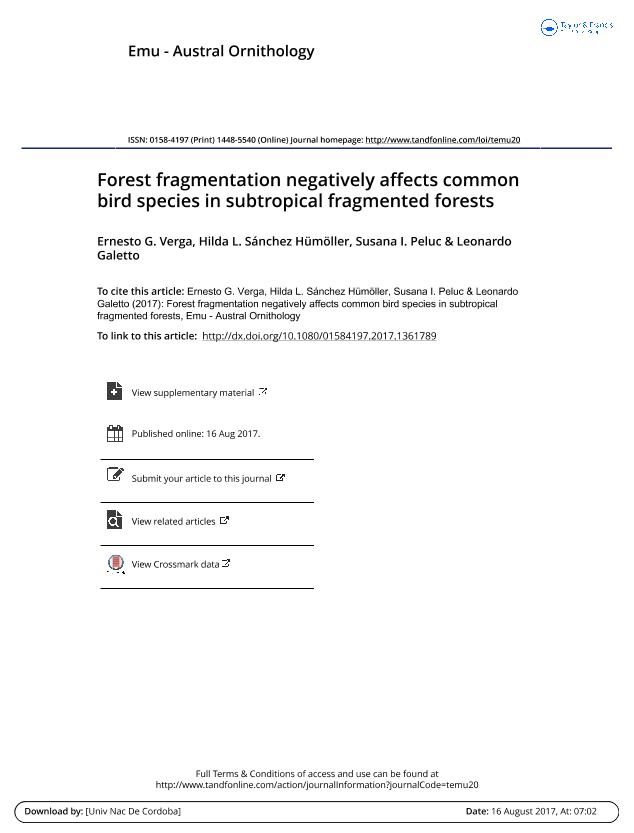Artículo
Forest fragmentation negatively affects common bird species in subtropical fragmented forests
Fecha de publicación:
08/2017
Editorial:
Csiro Publishing
Revista:
Emu
ISSN:
0158-4197
e-ISSN:
1448-5540
Idioma:
Inglés
Tipo de recurso:
Artículo publicado
Clasificación temática:
Resumen
Forest fragmentation threatens bird species throughout the world. Previous studies suggest that the sensitivity of bird species to forest fragmentation is related to food abundance, and that this could be a key factor in understanding demographic changes. We assessed the relationship between forest fragment size, isolation and food abundance and the abundance of seven common species of birds in southern Chaco forests of Argentina, which use different food items, and are involved in different ecosystem processes. Relative abundance of Turdus amaurochalinus (Creamy-bellied Thrush) and Saltator aurantiirostris (Golden-billed Saltator) significantly decreased with patch size reduction, whereas relative abundance of Taraba major (Great Antshrike) decreased with patch isolation and increased with arthropod abundance. Chlorostilbon lucidus (Glittering-bellied Emerald), Elaenia parvirostris (Small-billed Elaenia), Polioptila dumicola (Masked Gnatcatcher) and Zonotrichia capensis (Rufous-collared Sparrow) appeared to be resilient to forest fragmentation. Body size was a good predictor of bird sensitivity, as only the largest species were negatively correlated with forest fragmentation. Previous work suggests that birds inhabiting Chaco forests may be resilient to forest fragmentation. This needs to be reconsidered in the light of our results since the abundance of three out of seven common bird species were negatively related to forest fragmentation.
Palabras clave:
Body Size
,
Food Abundance
,
Isolation
,
Patch Size
,
Species-Specific Response
Archivos asociados
Licencia
Identificadores
Colecciones
Articulos(IMBIV)
Articulos de INST.MULTIDISCIPL.DE BIOLOGIA VEGETAL (P)
Articulos de INST.MULTIDISCIPL.DE BIOLOGIA VEGETAL (P)
Citación
Verga, Ernesto Gustavo; Sanchez Humoller, Hilda Leticia; Peluc, Susana Ines; Galetto, Leonardo; Forest fragmentation negatively affects common bird species in subtropical fragmented forests; Csiro Publishing; Emu; 117; 4; 8-2017; 359-369
Compartir




